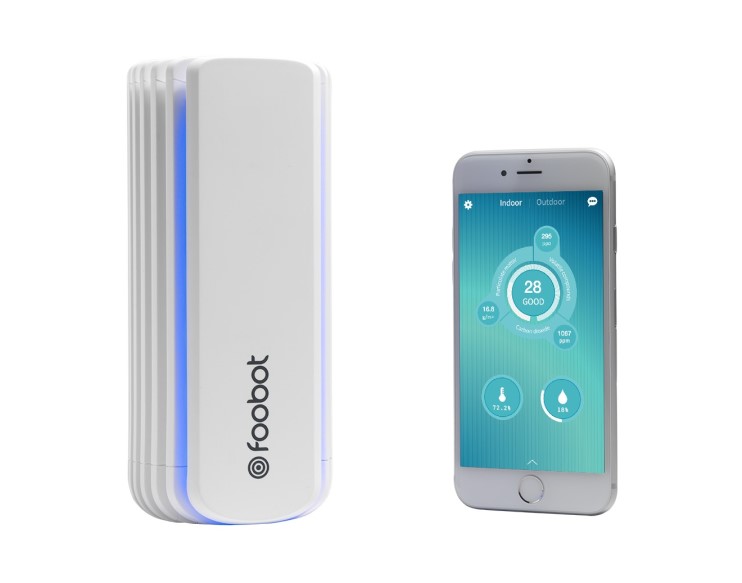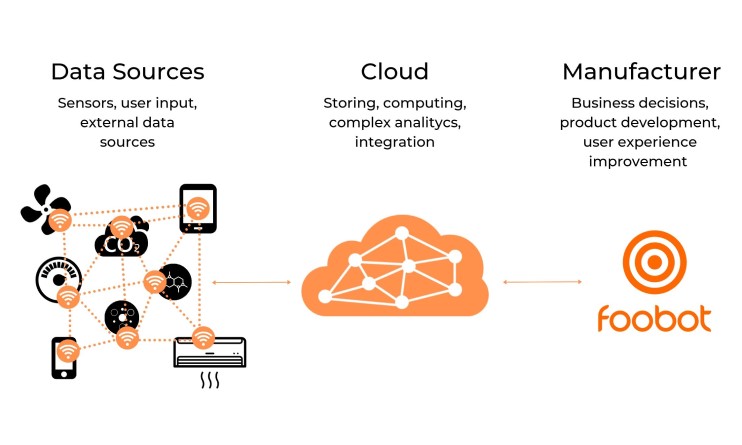Getting started with IoT for your products

American writer Stewart Brand once said: “Once a new technology rolls over you, if you’re not part of the steamroller, you’re part of the road.”
The Internet of Things (IoT) most definitely falls into that category. The IoT is taking everyday household objects and connecting them to the internet allowing them to create and share data.
In the last few years, we have seen some wonderful and bizarre ideas come to life thanks to the IoT. One device that grabs the attention is Furbo’s Nest Cam for dogs – this allows you to monitor your pets and to communicate with them remotely, while you can also fire some treats out to your dog via your smartphone.
Five years ago, we wouldn’t have said that a dog cam would be classed as a household item and it certainly wouldn’t have been a necessity. Thanks to the IoT, it is now becoming one.
One question you need to ask yourself is ‘Why do I need my product connected to the internet?’
This question can be broken down into three sections and they all focus on ‘why’:
- Why is this necessary? – are you meeting the needs of the user?
- Why is it helpful – Does it solve any problems?
- Why is it worthwhile – Does it compliment other aspects of your company’s business model?
It’s important to understand the benefits of what connecting to the Internet of Things can do to your products before you get started.
The Internet of Things is very popular in the HVAC industry and we’ve explained here how well they work together.
There’s always the urge to create something groundbreaking, but it’s better to play safe and get the basics right.
Read on to discover how you can get started with the Internet of Things for your product.
Key steps to get started
The most important thing to understand when starting a project like this is, it won’t have the intended impact if you neglect to verify your assumptions, like the customers’ willingness to pay. This aspect of your project needs to be thorough.
Don’t just assume that because the majority of companies are creating IoT products for their customers, that yours will want identical products. Understand the needs of your customers by asking them questions, so you can get a feel for any interest before the hard work starts.

Foobot is an IoT product that makes something invisible, such as indoor air quality, visible, and in a way that is both affordable for the end user and profitable for the manufacturer.
You need to be convinced that your customers really need this product. Listen to them and understand what they want from a product like this. It’s been recommended that companies consult their customers at least twice before implementing any new technology.
As well as consulting with your customers, you – as a company – should be asking yourself questions on whether or not it’s the right step to take.
These questions should include:
- Does your product NEED to be connected to the internet?
- What data will it actually be collecting?
- How is the data stored and used?
- What happens if the manufacturer goes out of business?
What to focus on
While creating your IoT product, it’s important to focus on four major components that will effectively determine if your product will be a success.
1. Sensors/Devices
The sensors or devices used in your IoT project will collect data from their environment. On its own, a sensor is not as effective as when it’s placed in an electronic system. A sensor can measure a given parameter and then transform it into an electric signal, which then becomes data.
2. Connectivity
Once you’ve collected all your data, it will be sent to the cloud – but how does that happen?
The sensors or devices can be connected to the cloud in a number of ways, these can be cellular, satellite, Wi-Fi, Bluetooth, connecting through a router or directly to the internet courtesy of an ethernet.
3. Data Processing
Once the data and the cloud are fully connected, the cloud software then processes it. This is another important aspect, as according to McKinsey 90% of all the data in the world today has been produced in the last two years.
4. User Interface
After the data has been processed it will find its way to the end-user. Not all interfaces will be the same. For example, you could receive a notification informing you of the temperature in your office, prompting you to use the device to turn it up or down.
Using the cloud to your advantage
A lot of IoT projects contain a number of sensors in order to collect the necessary data and using the cloud for these purposes is highly recommended. When you have thousands of sensors working together putting more processing power and storing capacity on each device could prove to be very costly. Being connected to the cloud sees this data passed around and in turn, is more effective.

How we leverage the Cloud at EnergyWise.
Amazon Web Services is a good example of how connecting to the cloud can be very beneficial. This service provides on-demand cloud computing platforms to governments, companies and individuals.
The AWS Cloud provides infrastructure services, such as computing power, storage options and networking as part of an on-demand platform with pay-as-you-go pricing options.
Expect changes
When you are working on your IoT product, it’s important not to have all your plans set in stone. Be flexible in what you want to design. You may feel your original ideas are perfect, but because of the obstacles you’ll hit, your thought process may need to change.
It’s imperative you use a formula like the SCRUM Agile framework. Scrum is a subset of Agile and is predominantly used to manage software and product development. It was designed to allow companies to make smooth adjustments and create a top quality product.
Get expert advice
Asking for help is not a weakness. Gaining support and advice will help your project become a success. Reach out to companies that have a decent track record in creating IoT products. Arrange meetings with IoT Product Managers and attend trade shows to gain insight into what has made them successful.
Don’t be afraid to ask questions. It’s better in the long run if you cover all the bases in terms of how the whole process works. Even listen to podcasts dedicated to the Internet of Things – the more knowledge and information you have regarding what to do, the more efficient your overall product will be.
As well as gaining outside expert advice, it’s very important to have a close relationship with your engineers and developers. Don’t just pass your problems onto the next stage and expect them to instantly get it to work.
Having a close-knit team working towards the same end goal could reap rewards. Having ‘fresh eyes’ on a certain project could eliminate problems early on.
Thanks for reading
Remember, you may believe you have the greatest idea in the world, but if it doesn’t interest your customers then the idea will not take off.
Put the needs of your customers first, if they don’t buy into it then your Return on Investment (ROI) will be non-existent.
It’s important to understand that you can’t do this on your own, get outside help and advice on how to create an IoT product. Make sure you do the relevant research and cover all the bases when it comes to deciding whether or not to proceed.
